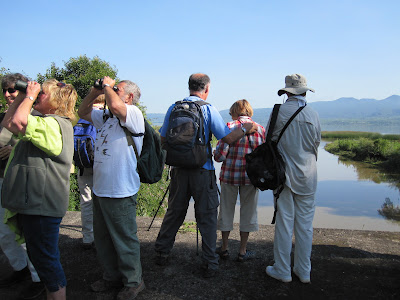 The first sight of the waterfalls
The first sight of the waterfallsToday Mike Judd and I birded La Tzararacua, the waterfalls located 10 km south of Uruapan. (I have mentioned this location previously, and you can look at that posting for additional information and photos.) Until today I wasn't able to get good enough looks to identify any of the swifts. Today I was lucky! More than two dozen White-naped swifts were found huddled and flying around the waterfalls.
After making our way down the stair-filled path to the main waterfalls to where American dippers were again easily espied, we hiked beyond the falls to the opposite side of the valley. Just short of a smaller waterfall known as Tzararacuita, several Grace's warblers entertained us.
After making our way down the stair-filled path to the main waterfalls to where American dippers were again easily espied, we hiked beyond the falls to the opposite side of the valley. Just short of a smaller waterfall known as Tzararacuita, several Grace's warblers entertained us.

That's me!

And me again...with both the big Sibley's and Howell & Webb in my back pocket.
It was a beautiful day - no rain, pleasant weather, few people in the park, no biting insects, cold beers, and afterwards a sumptious meal in town. I added two birds to my life list: White-naped swifts and Greenish elaenia. All birds seen today are listed at the end of this posting.
Cold beers were thirst-quenching after climbing the stairs back to the car

As I mentioned, we ventured into el centro de Uruapan for lunch. OH MY GAWD, OUR MEAL WAS HEAVENLY. In fact, the best meal I've had in Mexico.
We both had Chile Costeno (not the English n), which was stuffed with shrimp, squash flower, onion and other goodies served on a tomato-flavored rice pilaf and surrounded by a puree of frijoles decorated with a zigzag of crema. Savored with a slightly chilled chardonnay, we thought we'd died and went to heaven. Then there was dessert, which we shared: flamed bananas with brandy and kahlua with a large dollup of vanilla ice cream. Our waiters (Carlos and Sergio) couldn't have been more professional. Price tag for the main course was $85 pesos and dessert was $40 pesos. According to Carlos who speaks English, the chef is exceptional. When pressed, Carlos couldn't recommend one dish more than another.
Neither of us can wait to return. Mind you, Uruapan isn't much to look at, and I probably wouldn't return unless to the cascadas (waterfalls) or the national park, but I will make a trip solely to eat at this restaurant.
The restaurant is located on the second floor of Hotel Plaza Uruapan, Ocampo no. 64, Central Uruapan. http://www.hotelplazauruapan.com.mx/.
So, any of you who think birding is dull, rest assured there is another side. We visit interesting places, see gorgeous birds, and eat sumptious meals as often as we can.
Bird seen (not in taxonomic order):
Inca dove
White-throated robin
Great-tailed grackle
Acorn woodpecker
Green heron
Spotted wren
Canyon wren
 Bridled titmouse
Bridled titmouseSquirrel cuckoo
Spotted sandpiper
American dipper (Spanish name: mirlo-aquatico americano)
White-naped swift (Spanish name: vencejo nuquiblanco)

Photo by Bruce Cox, Patzcuaro
Rose-throated becard
Brown-backed solitaire
Lesser goldfinch
Greenish elaneia
Grace's warbler
Black vulture
Berylline hummingbird















